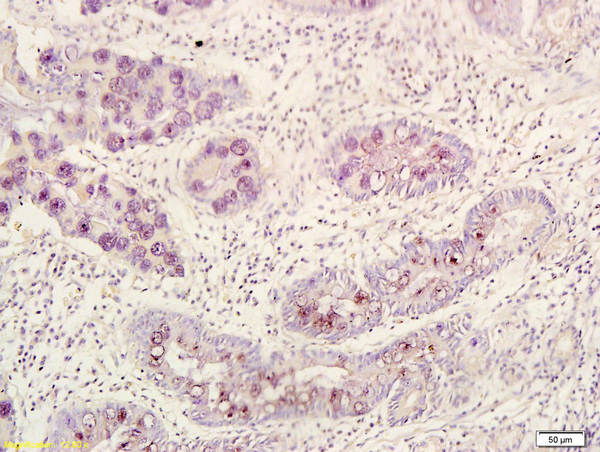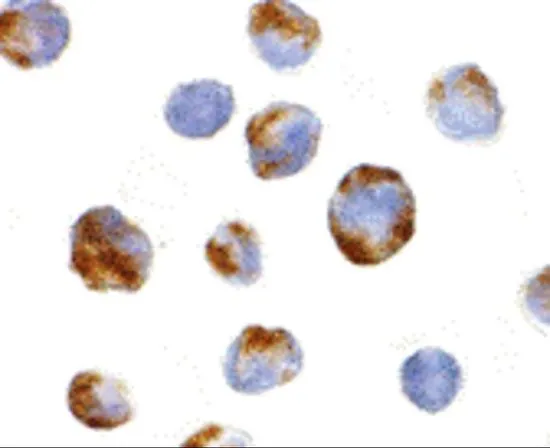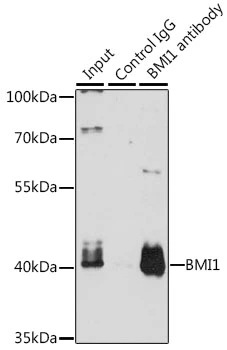Bmi1 antibody
GTX114008
ApplicationsImmunoFluorescence, ImmunoPrecipitation, Western Blot, ImmunoCytoChemistry, ImmunoHistoChemistry, ImmunoHistoChemistry Paraffin
Product group Antibodies
TargetBMI1
Overview
- SupplierGeneTex
- Product NameBmi1 antibody
- Delivery Days Customer9
- Application Supplier NoteWB: 1:500-1:3000. ICC/IF: 1:100-1:1000. IHC-P: 1:100-1:1000. IP: 1:100-1:1000. *Optimal dilutions/concentrations should be determined by the researcher.Not tested in other applications.
- ApplicationsImmunoFluorescence, ImmunoPrecipitation, Western Blot, ImmunoCytoChemistry, ImmunoHistoChemistry, ImmunoHistoChemistry Paraffin
- CertificationResearch Use Only
- ClonalityPolyclonal
- Concentration1 mg/ml
- ConjugateUnconjugated
- Gene ID648
- Target nameBMI1
- Target descriptionBMI1 proto-oncogene, polycomb ring finger
- Target synonymsFLVI2/BMI1, PCGF4, RNF51, flvi-2/bmi-1, polycomb complex protein BMI-1, B lymphoma Mo-MLV insertion region 1 homolog, BMI1 polycomb ring finger oncogene, BMI1 polycomb ring finger proto-oncogene, murine leukemia viral (bmi-1) oncogene homolog, polycomb group RING finger protein 4, polycomb group protein Bmi1, ring finger protein 51
- HostRabbit
- IsotypeIgG
- Protein IDP35226
- Protein NamePolycomb complex protein BMI-1
- Scientific DescriptionComponent of the Polycomb group (PcG) multiprotein PRC1 complex, a complex required to maintain the transcriptionally repressive state of many genes, including Hox genes, throughout development. PcG PRC1 complex acts via chromatin remodeling and modification of histones; it mediates monoubiquitination of histone H2A Lys-119, rendering chromatin heritably changed in its expressibility. In the PRC1 complex, it is required to stimulate the E3 ubiquitin-protein ligase activity of RNF2/RING2.
- Storage Instruction-20°C or -80°C,2°C to 8°C
- UNSPSC12352203
References
- Yen YT, Yang JC, Chang JB, et al. Down-Regulation of miR-194-5p for Predicting Metastasis in Breast Cancer Cells. Int J Mol Sci. 2021,23(1). doi: 10.3390/ijms23010325Read this paper
- Chien CH, Chuang JY, Yang ST, et al. Enrichment of superoxide dismutase 2 in glioblastoma confers to acquisition of temozolomide resistance that is associated with tumor-initiating cell subsets. J Biomed Sci. 2019,26(1):77. doi: 10.1186/s12929-019-0565-2Read this paper
- Lai YJ, Yu WN, Kuo SC, et al. CSC-3436 inhibits TWIST-induced epithelial-mesenchymal transition via the suppression of Twist/Bmi1/Akt pathway in head and neck squamous cell carcinoma. J Cell Physiol. 2019,234(6):9118-9129. doi: 10.1002/jcp.27589Read this paper
- Chang KY, Huang CT, Hsu TI, et al. Stress stimuli induce cancer-stemness gene expression via Sp1 activation leading to therapeutic resistance in glioblastoma. Biochem Biophys Res Commun. 2017,493(1):14-19. doi: 10.1016/j.bbrc.2017.09.095Read this paper
- Huang CF, Chen L, Li YC, et al. NLRP3 inflammasome activation promotes inflammation-induced carcinogenesis in head and neck squamous cell carcinoma. J Exp Clin Cancer Res. 2017,36(1):116. doi: 10.1186/s13046-017-0589-yRead this paper
- Wang Y, Chen H, et al. Endothelial Cells Promote Formation of Medulloblastoma Stem-Like Cells via Notch Pathway Activation. J Mol Neurosci. 2017,63(2):152-158. doi: 10.1007/s12031-017-0965-2Read this paper
- Huynh N, Wang K, Yim M, et al. Depletion of p21-activated kinase 1 up-regulates the immune system of APC(∆14/+) mice and inhibits intestinal tumorigenesis. BMC Cancer. 2017,17(1):431. doi: 10.1186/s12885-017-3432-0Read this paper
- Ko CY, Lin CH, Chuang JY, et al. MDM2 Degrades Deacetylated Nucleolin Through Ubiquitination to Promote Glioma Stem-Like Cell Enrichment for Chemotherapeutic Resistance. Mol Neurobiol. 2018,55(4):3211-3223. doi: 10.1007/s12035-017-0569-4Read this paper
- Wang LT, Chiou SS, Chai CY, et al. Transcription factor SPZ1 promotes TWIST-mediated epithelial-mesenchymal transition and oncogenesis in human liver cancer. Oncogene. 2017,36(31):4405-4414. doi: 10.1038/onc.2017.69Read this paper
- Hsu CC, Chang WC, Hsu TI, et al. Suberoylanilide hydroxamic acid represses glioma stem-like cells. J Biomed Sci. 2016,23(1):81.Read this paper






